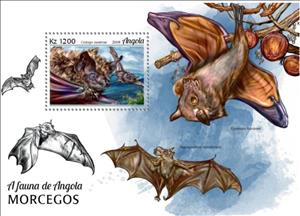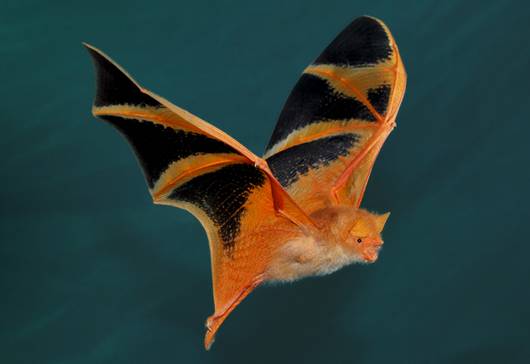Souvenir Sheet: Cistugo seabrae & Epomops franqueti & Hypsignathus monstrosu (Angola 2018)
Cistugo seabrae & Epomops franqueti & Hypsignathus monstrosu (Angola 2018)
10 December (Angola ) within release Bats (2018) goes into circulation Souvenir Sheet Cistugo seabrae & Epomops franqueti & Hypsignathus monstrosu face value 1,200 Angolan kwanza
| Souvenir Sheet Cistugo seabrae & Epomops franqueti & Hypsignathus monstrosu in catalogues | |
|---|---|
| Michel: | Mi: AO BL170 |
Souvenir Sheet is horizontal format.
Although this issue was authorized by the postal administration of Angola, the issue was not placed on sale in Angola, and was only distributed to the new issue trade by Angola's philatelic agent.Also in the issue Bats (2018):
- Stamp - Mops condylurus face value 300;
- Stamp - Cistugo seabrae face value 1,200;
- Stamp - Epomops franqueti face value 300;
- Souvenir Sheet - Cistugo seabrae & Epomops franqueti & Hypsignathus monstrosu face value 1,200;
- Stamp - Epomophorus crypturus face value 300;
- Stamp - Hypsignathus monstrosus face value 300;
- Full Pane - Angolan Free-tailed Bat (Mops condylurus) face value 10*300;
- Full Pane - Franquet's Epauletted Fruit Bat (Epomops franqueti) face value 10*300;
- Full Pane - Hammer-headed Fruit Bat (Hypsignathus monstrosus) face value 10*300;
- Full Pane - Peters's Epauletted Fruit Bat (Epomophorus crypturus) face value 10*300;
Souvenir Sheet Cistugo seabrae & Epomops franqueti & Hypsignathus monstrosu it reflects the thematic directions:
Animals are multicellular, eukaryotic organisms of the kingdom Animalia (also called Metazoa). All animals are motile, meaning they can move spontaneously and independently, at some point in their lives. Their body plan eventually becomes fixed as they develop, although some undergo a process of metamorphosis later on in their lives. All animals are heterotrophs: they must ingest other organisms or their products for sustenance.
Bats are flying mammals of the order Chiroptera (/kaɪˈrɒptərə/). With their forelimbs adapted as wings, they are the only mammals capable of true and sustained flight. Bats are more agile in flight than most birds, flying with their very long spread-out digits covered with a thin membrane or patagium. The smallest bat, and arguably the smallest extant mammal, is Kitti's hog-nosed bat, which is 29–34 millimetres (1+1⁄8–1+3⁄8 inches) in length, 150 mm (6 in) across the wings and 2–2.6 g (1⁄16–3⁄32 oz) in mass. The largest bats are the flying foxes, with the giant golden-crowned flying fox (Acerodon jubatus) reaching a weight of 1.6 kg (3+1⁄2 lb) and having a wingspan of 1.7 m (5 ft 7 in).
Mammals are any vertebrates within the class Mammalia (/məˈmeɪli.ə/ from Latin mamma "breast"), a clade of endothermic amniotes distinguished from reptiles (including birds) by the possession of a neocortex (a region of the brain), hair, three middle ear bones and mammary glands. All female mammals nurse their young with milk, secreted from the mammary glands. Mammals include the largest animals on the planet, the great whales. The basic body type is a terrestrial quadruped, but some mammals are adapted for life at sea, in the air, in trees, underground or on two legs. The largest group of mammals, the placentals, have a placenta, which enables the feeding of the fetus during gestation. Mammals range in size from the 30–40 mm (1.2–1.6 in) bumblebee bat to the 30-meter (98 ft) blue whale. With the exception of the five species of monotreme (egg-laying mammals), all modern mammals give birth to live young. Most mammals, including the six most species-rich orders, belong to the placental group. The largest orders are the rodents, bats and Soricomorpha (shrews and allies). The next three biggest orders, depending on the biological classification scheme used, are the Primates (apes and monkeys), the Cetartiodactyla (whales and even-toed ungulates), and the Carnivora (cats, dogs, seals, and allies).



